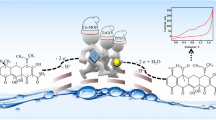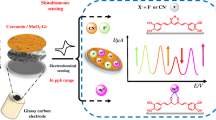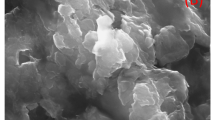Abstract
Herein, using 1, 3 indandione and three thiophene unit by Suzuki coupling reaction, small organic oligomer–based indandione derivative, 2-(5″-hexyl-[2,2′:5′2″ terthiophen]-5-yl) methylene)-1H-indene-1,3(2H) dione oligomer (HTD) was synthesized. A functional and highly effective nanocomposite based on the synthesized HTD oligomer and graphene oxide (GO) was further synthesized and utilized to fabricate high-sensitive and selective chemical sensor. The synthesized HTD@GO functionalized nanocomposites were further examined by several techniques and finally coated on the glassy carbon electrode (GCE) to fabricate the chemical sensor. Due to the synergistic impacts of HTD oligomer and GO, the functionalized HTD@GO nanocomposite exhibited outstanding physiochemical, structural, and surface characteristics. Thus, using an electrochemical method, the HTD@GO/GCE sensor probe demonstrated the outstanding simultaneous trace detection of heavy metals such as Cr2+ and Cu2+ ions. The HTD@GO/GCE sensor probe revealed a strong selectivity towards Cr2+ and Cu2+ ions when compared to other metal ions (Al3+, Zn2+, K+, Mn2+). Importantly, the HTD@GO/GCE-based sensor exhibited relatively good dynamic linear ranges of 1–100 µM and detection limit values of ~3.65 μM and ~2.25 μM, respectively, for trace Cr2+ and Cu2+ ions. The HTD@GO/GCE sensor probe has low relative standard deviations (RSDs) of ~10% and ~6.4% for Cr2+ and Cu2+ ions, respectively, as suggested by the repeatability test. Analyzing actual water samples was also used to test the reliability of the functionalized nanocomposite sensor.
Graphical abstract
HTD@GO/GCE-based-sensor presents good detection limit values of ~3.65 μM and ~2.25 μM with excellent linear dynamic for Cr2+ and Cu2+ ions, respectively.










Similar content being viewed by others
References
Kim EB, Imran M, Akhtar MS, Shin HS, Ameen S (2021) Enticing 3D peony-like ZnGa2O4 microstructures for electrochemical detection of N, N-dimethylmethanamide chemical. J Hazar Mater 404:124069
Rahman MA, Park DS, Shim YB, Kumar P (2008) Electrochemical sensors based on organic conjugated polymers. Sensors 8:118–141
Guo J, Li X, Liu H, Young DP, Song G, Song K, Zhu J, Kong J, Guo Z (2021) Tunable magnetoresistance of core-shell structured polyaniline nanocomposites with 0-, 1-, and 2-dimensional nanocarbons. Adv Composites Hybrid Mater 4:51–64
Chen J, Zhu Y, Guo Z, Nasibulin AG (2020) Recent progress on thermo-electrical properties of conductive polymer composites and their application in temperature sensors. Eng Sci 12:13–22
Rehman S, Ahmed R, Ma K, Xu S, Tao T, Aslam MA, Wang AM (2021) J composite of strip-shaped ZIF-67 with polypyrrole: a conductive polymer-MOF electrode system for stable and high specific capacitance. Eng Sci 13:11–23
Elayappan V, Murugadoss V, Fei Z, Angaiah DPJ, S, (2020) Influence of polypyrrole incorporated electrospun poly(vinylidene fluoride-co-hexafluoropropylene) nanofibrous composite membrane electrolyte on the photovoltaic performance of dye sensitized solar cell. Eng Sci 1:78–84
Guo J, Chen Z, Abdul W, Kong J, Khan MA, Young DP, Zhu J, Guo Z (2021) Tunable positive magnetoresistance of magnetic polyaniline nanocomposites. Advan Comp Hybrid Mater 4:534–542
Guo J, Li X, Chen Z, Zhu J, Mai X, Wei R, Sun K, Liu H, Chen Y, Naik N, Guo Z (2022) Magnetic NiFe2O4/Polypyrrole nanocomposites with enhanced electromagnetic wave absorption. J Mater Sci Technol 108:64–72
Park MO, Seo KD, Shim YB, Yoon JH, Park DS (2019) Chromium (VI) sensor based on catalytic reduction using the nanoporous layer of poly (aminopyrimidyl-terthiophene) and AuNi composite. Sen Act B: Chem 301:127151–127159
Choi SM, Kim DM, Jung OS, Shim YB (2015) A disposable chronocoulometric sensor for heavy metal ions using a diaminoterthiophene-modified electrode doped with graphene oxide. Anal Chim Acta 892:77–84
Lee WC, Kim KB, Gurudatt NG, Hussain KK, Choi CS, Park DS, Shim YB (2019) Comparison of enzymatic and non-enzymatic glucose sensors based on hierarchical Au-Ni alloy with conductive polymer. Biosen Bioelectr 130:48–54
Srivani D, Gupta A, Bhosale SV, Puyad AL, Xiang W, Li J, Evansf RA (2017) Non-fullerene acceptors based on central naphthalene diimide flanked by rhodamine or 1,3-indanedione. Chem Comm 53:7080–7083
Razzaque S, Wang K, Hussain I, Tan B (2019) Facile synthesis of hyper crosslinked hollow microporous organic capsules for electrochemical sensing of Cu(II) ions. Chem Eur J 25:548–555
Nordberg GF, Fowler BA, Nordberg M, Friberg L (2007) Handbook on the toxicology of metals, 3rd edn. Elsevier, Amsterdam
Ramalingam S, Subramania A (2021) Effective removal of nitrates from the drinking water by chemical and electrochemical methods. Eng Sci 15:80–88
Al-Zhrani S, Bedaiwi NM, El-Ramli IF, Barasheed AZ, Abduldaiem A, Al-Hadeethi Y, Umar, (2021) A underwater optical communications: a brief overview and recent developments. Eng Sci 16:146–186
Lu YY, Liang XQ, Xu JM, Zhao ZY, Tian GM (2018) Synthesis of CuZrO3 Nanocomposites/Graphene and their application in modified electrodes for the Co-detection of trace Pb(II) and Cd(II). Sens Actuat B: Chem 273:1146–1155
Nidamanuri N, Li Y, Li Q, Dong M (2020) Graphene and graphene oxide-based membranes for gas separation. Eng Sci 9:3–16
Moradi O, Madanpisheh MA, Moghaddas M (2021) Synthesis of GO/HEMA, GO/ HEMA/TiO2, and GO/Fe3O4/HEMA as novel nanocomposites and their dye removal ability. Adv Compos Hybrid Mater 4:1185–1204
Aggrwal G, Salunke-Gawali S, Gejji SP, Nikalje M, Chakravarty D, Verma PL, Gosavi-Mirkute P, Harihar S, Jadhav M, Puranik VG (2021) Reactions of 2, 3-dibromonaphthalene-1, 4-dione and pyridyl amines: X-ray structures, DFT investigations, and selective detection of the Hg2+ and Ni2+ Ions. Eng Sci 14:78–93
Hamilton MA, Rode PW, Merchant ME, Sneddon J (2008) Determination and comparison of heavy metals in selected seafood, water, vegetation and sediments by inductively coupled plasma-optical emission spectrometry from an industrialized and pristine waterway in Southwest Louisiana. Micro Chem J 88:52–55
Sen I, Shandil A, Shrivastava VS (2011) Study for determination of heavy metals in fish species of the River Yamuna (Delhi) by inductively coupled plasma-optical emission spectroscopy (ICP-OES). Adv In App Sci Res 2:161–166
Pizarro J, Segura R, Tapi D, Navarr F, Fuenzalid F, Aguirre MJ (2020) Inexpensive and green electrochemical sensor for the determination of Cd (II) and Pb (II) by square wave anodic stripping voltammetry in bivalve mollusks. Food Chem 321:126682
Lu M, Deng Y, Luo Y, Lv J, Li T, Xu J, Chen SW, Wang J (2019) Graphene aerogelmetal- organic framework-based electrochemical method for simultaneous detection of multiple heavy-metal ions. Anal Chem 91:888–895
Pooja S, Laiju RK, Utkarsh C, Chandrakala CB (2021) Face detection using deep learning to ensure a coercion resistant blockchain-based electronic voting. Eng Sci 16:341–353
Hong J, Kang L, Shi X, Wei R, Mai X, Pan D, Naik N, Guo Z (2022) Highly efficient removal of trace lead (II) from wastewater by 1,4-dicarboxybenzene modified Fe/Co metal organic nanosheets. J Mater Sci Technol 98:212–218
Adraoui I, Rhazi ME, Amine A, Idrissi L, Curulli A, Palleschi G (2005) Modulation of electrical properties in single-walled carbon nanotube/conducting polymer composites. Electroanalysis 17:685–693
Renaudin SG, Moreau M, Despas C, Meyer M, Denat F, Lebeau B, Walcarius A (2009) Voltammetric detection of Pb (II) using amide-cyclam-functionalized silica-modified carbon paste electrodes. Electroanalysis 21:1731–1742
Armstrong KC, Tatum CE, Chambers RND, Sparks JQ, Xue ZL (2010) Individual and simultaneous determination of lead, cadmium, and zinc by anodic stripping voltammetry at a bismuth bulk electrode. Talanta 82:675–680
Wang X, Qi Y, Shen Y, Yuan Y, Zhang L, Zhang C, Sun Y (2020) A ratiometric electrochemical sensor for simultaneous detection of multiple heavy metal ions based on ferrocene-functionalized metal-organic framework. Sen Actuat B: Chem 310:127756–127769
Xu Z, Liu Z, Xiao M, Jiang L, Yi C (2020) A smartphone-based quantitative point-of-care testing (POCT) system for simultaneous detection of multiple heavy metal ions. Chem Eng J 394:124966–124975
Suvina V, Krishna SM, Nagaraju DH, Melo JS, Balakrishna RG (2018) Polypyrrole-reduced graphene oxide nanocomposite hydrogels: a promising electrode material for the simultaneous detection of multiple heavy metal ions. Mater Lett 232:209–212
Peng QM, Guo JX, Zhang QR, Xiang JY, Liu BZ, Zhou AG, Liu RP, Tian YJ (2014) Unique lead adsorption behavior of activated hydroxyl group in two dimensional titanium carbide. J Am Chem Soc 136:4113–4116
Deng W, Tan Y, Fang Z, Xie Q, Li Y, Liang X, Yao S (2009) ABTS-multiwalled carbon nanotubes nanocomposite/Bi film electrode for sensitive determination of Cd and Pb by differential pulse stripping voltammetry. Electroanalysis 21:2477–2485
Zhang DC, Zhang X, Chen Y, Yu P, Wang CH, Ma YW (2011) Enhanced capacitance and rate capability of graphene/polypyrrole composite as electrode material for supercapacitors. J Power Sour 196:5990–5996
Alam S, Akhtar MS, Abdullah KEB, Shin HS, Ameen S (2020) New energetic indandione based planar donor for stable and efficient organic solar cells. Sol Energy 201:649–657
Ameen S, Akhtar MS, Seo HK, Shin HS (2014) ZnO quantum dots engrafted graphene oxide thin film electrode for low level detection of ethylacetate. Mater Lett 136:379–383
Xu YX, Bai H, Lu GW, Li C, Shi GQ (2008) Chemically converted graphene induced molecular flattening of 5,10,15,20-tetrakis(1-methyl-4-pyridinio) porphyrin and its application for optical detection of cadmium (II) ions. J Am Chem Soc 130:5856–5857
Gupta V, Lai LF, Datt R, Chand S, Heeger AJ, Bazan GC, Singh SP (2016) Dithienogermole-based solution-processed molecular solar cells with efficiency over 9 %. Chem Comm 52:8596–8599
Venugopal GD, Krishnamoorthy K, Mohan R, Kim SJ (2012) An investigation of the electrical transport properties of graphene-oxide thin films. Mat Chem Phys 132:29–33
Wang H, Hao Q, Yang X, Lu L, Wang X (2010) Effect of graphene oxide on the properties of its composite with polyaniline. ACS Appl Mater Inter 2:821–828
Revoju S, Biswas S, Eliasson B, Sharma GD (2018) Effect of acceptor strength on optical, electrochemical and photovoltaic properties of phenothiazine-based small molecule for bulk heterojunction organic solar cells. Dyes Pigm 149:830–842
Perjéssy A, Hrnčiar P (1971) The C=O stretching bands of 1,3-indandione derivatives. Tetrahedron 27:6159–6169
Kaneti J, Yuchnovski I (1970) Electronic substituent effects and carbonyl stretching frequencies of 2-arylmethylene-1, 3-indandiones. Tetrahedron 26:4397–4402
Bera M, Chandravati GP, Maji PK (2018) Facile one-pot synthesis of graphene oxide by sonication assisted mechanochemical approach and its surface chemistry. J Nanosci Nanotech 18:902–912
Ferrari AC, Robertson J (2000) Interpretation of Raman spectra of disordered and amorphous carbon. Phys Rev B 61:14095–14107
Cancado LG, Pimenta MA, Neves BRA, Dantas MSS, Jorio A (2004) Influence of the atomic structure on the Raman spectra of graphite edges. Phys Rev Lett 93:247401–247405
Ameen S, Akhtar MS, Shin HS (2012) Hydrazine chemical sensing by modified electrode based on in situ electrochemically synthesized polyaniline/graphene composite thin film. Sens Actuat B: Chem 173:177–183
Tang L, Wang Y, Li Y, Feng H, Lu J, Li J (2009) Preparation, structure, and electrochemical properties of reduced graphene sheet films. Adv Funct Mater 19:2782–2789
Akhavan O (2010) The effect of heat treatment on formation of graphene thin films from graphene oxide. Carbon 48:509–519
Yang D, Velamakanni A, Bozoklu G, Park S, Stoller M, Piner RD, Stankovich S, Jung I, Field DA, Ventrice CA, Ruoff RS (2009) Chemical analysis of graphene oxide films after heat and chemical treatments by X-ray photoelectron and micro-Raman spectroscopy. Carbon 47:145–152
Ye J, He F, Nie J, Cao Y, Yang H, Ai X (2015) Sulfur/carbon nanocomposite-filled polyacrylonitrile nanofibers as a long life and high capacity cathode for lithium-sulfur batteries. J Mater Chem A 3:7406–7412
Wang X, Gao T, Han F, Ma Z, Zhang Z, Li J, Wang C (2016) Stabilizing high sulfur loading Li–S batteries by chemisorption of polysulfide on three-dimensional current collector. Nano Ener 30:700–708
Lee EJH, Zhi LJ, Burghard M, Mullen K, Kern K (2010) Electrical properties and photoconductivity of stacked-graphene carbon nanotubes. Adv Mat 22:1854–1857
Pizarro J, Segura R, Tapia D, Navarro F, Fuenzalida F, Aguirre MJ (2020) Inexpensive and green electrochemical sensor for the determination of Cd (II) and Pb (II) by square wave anodic stripping voltammetry in bivalve mollusks. Food Chem 321:126682
Oztekin Y, Ramanaviciene A, Ramanavicius A (2011) Electrochemical copper (II) sensor based on self-assembled 4-amino-6-hydroxy-2-mercaptopyrimidine monohydrate. Sens Actuat B Chem 155:612–617
Yasri NG, Halabi AJ, Istamboulie G, Noguer T (2011) Chronoamperometric determination of lead ions using PEDOT:PSS modified carbon electrodes. Talanta 85:2528–2533
Traore D, Abdelaziz ASM, Brou YS, Trokourey A (2014) Determination of Cu2+ by N, N-dichromone-p-phenylenediamine modified carbon paste electrode. Int J Biol Chem Sci 8:2773–2785
Wang Z, Liu E, Zhao X (2011) Glassy carbon electrode modified by conductive polyaniline coating for determination of trace lead and cadmium ions in acetate buffer solution. Thin Solid Films 519:5285–5289
Li Y, Shi Z, Zhang C, Wu X, Liu L, Guo C, Li CM (2021) Highly stable branched cationic polymer-functionalized black phosphorus electrochemical sensor for fast and direct ultratrace detection of copper ion. J Colloi Interf Sci 603:131–140
Syed A, Marraiki N, Al-Rashed S, Elgorban AM, Yassin MT (2021) A potent multifunctional MnS/Ag-polyvinylpyrrolidone nanocompositefor enhanced detection of Hg2+ from aqueous samples and itsphotocatalytic and antibacterial applications. Spectrochim Acta Mol Biomol Spectrosc 244:118844
Rahman MM, Alamry KA, Awual MR, Mekky AEM (2020) Efficient Hg(II) ionic probe development based on one-step synthesized diethyl thieno[2, 3-b]thiophene-2, 5-dicarboxylate (DETTDC2) onto glassy carbon electrode. Microchem J 152:104291
Yi W, He Z, Fei J, He X (2019) Sensitive electrochemical sensor based on poly(L-glutamic acid)/graphene oxide composite materialfor simultaneous detection of heavy metal ions. RSC Adv 9:17325–17334
Hashemi SA, Bahrani S, Mousavi SM, Omidifar N, Arjmand M, Lankarani KB, Ramakrishna S (2022) Simultaneous electrochemical detection of Cd and Pb in aquatic samples via coupled graphene with brominated white polyaniline flakes. Euro Polym J 162:110926
Funding
This research is supported by Korea Basic Science Institute under the R&D program (Project No. D010710) supervised by the Ministry of Science and ICT. This work was also supported by the national research Foundation of Korea (NRF) grant funded by the Korea government (MSIT) No-2019R1F1063999. E. B. Kim also received research grant from NRF Korea (Project No.: 2020R1A6A3A13070611). This paper was supported by the selection of research oriented professor of Jeonbuk National University in 2021. This paper is supported by the research funds of Jeonbuk National University in 2021.
Author information
Authors and Affiliations
Corresponding authors
Ethics declarations
Conflict of interest
The authors declare no competing interests.
Additional information
Publisher's Note
Springer Nature remains neutral with regard to jurisdictional claims in published maps and institutional affiliations.
Supplementary information
Below is the link to the electronic supplementary material.
Rights and permissions
About this article
Cite this article
Kim, EB., Imran, M., Umar, A. et al. Indandione oligomer@graphene oxide functionalized nanocomposites for enhanced and selective detection of trace Cr2+ and Cu2+ ions. Adv Compos Hybrid Mater 5, 1582–1594 (2022). https://doi.org/10.1007/s42114-022-00428-z
Received:
Revised:
Accepted:
Published:
Issue Date:
DOI: https://doi.org/10.1007/s42114-022-00428-z




